Performance Fuels

What is Specific Gravity and Why Should You Care?
- Category:
- Fuel Facts
by Grassroots Motorsports
Posted on 8/22/2024

Fuels can vary by so many different properties. The biggies are octane, oxygen, lead content, and something called specific gravity, which measures the ratio of a substance’s density against a standard. When that substance is a liquid, that standard is water.
Gasoline weighs less than water, and most blends have a specific gravity somewhere between 0.7 and 0.8. You might not choose a fuel based on its specific gravity, but that number can still reveal a lot.
Fuel Consistency: Race fuels can be called boutique products since they’re produced in small quantities to a very tight recipe. “With pump gas, there’s a huge variety from batch to batch and from refiner to refiner,” notes Zachary J. Santner, senior specialist of quality at Sunoco. “With our fuels, we don’t change the recipe ever.”
The material safety data sheets will confirm that fact. The specific gravity of Sunoco Race Fuels’ 260 GT, for example, is 0.734. For pump fuel, often just a range is provided, like maybe 0.7 to 0.8.
Burn Rate: All else being equal–same octane, lead and oxygen content–a lighter fuel burns faster. Take Sunoco’s Standard and Supreme fuels. Both are leaded, unoxygenated race fuels offering similar octane numbers: 110 and 112, respectively. However, the Supreme weighs less, so in theory it should burn a bit quicker.
Fuel Metering: Specific gravity can affect float level and thus carb setup. “Modern injected engines are smart enough to adjust on their own,” Santner explains. “The computer will need to adjust for a fuel with different specific gravity, but the driver would never really know.”
Fuel ID: The specific gravity of a fuel sample can also help identify it; Summit Racing advertises a fuel hydrometer kit for about $250. Then add in the fact that many race fuels are tinted at the refinery. If you have a green fuel with a specific gravity of 0.762, for example, there’s a good chance that it’s Sunoco 260 GTX.
Fuel Health: Fuels get heavier as they age. Blame evaporation. A hydrometer can be used to monitor the freshness of a drum of fuel.




